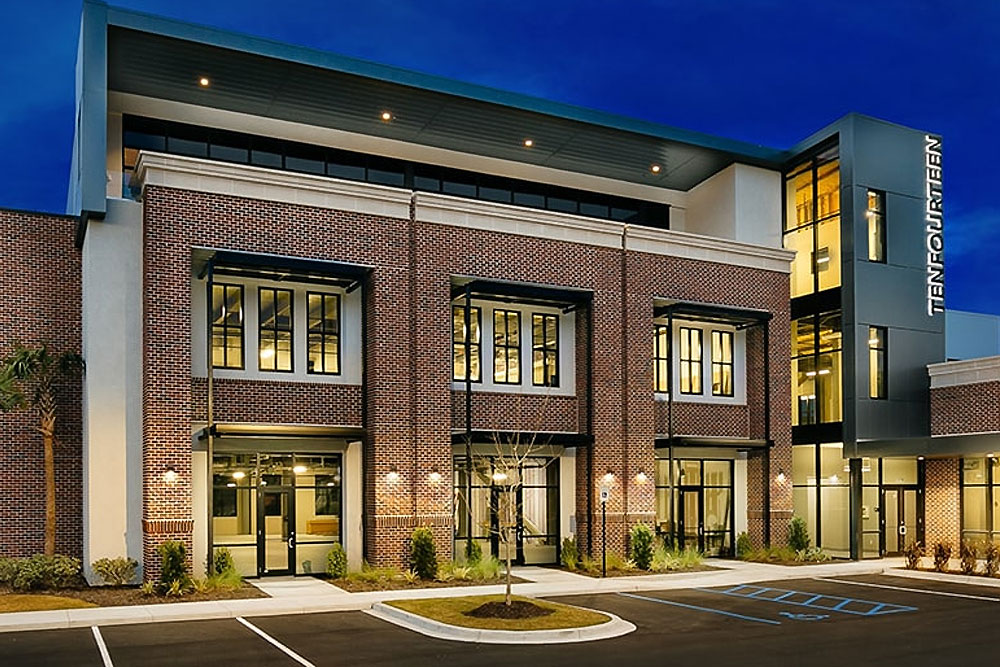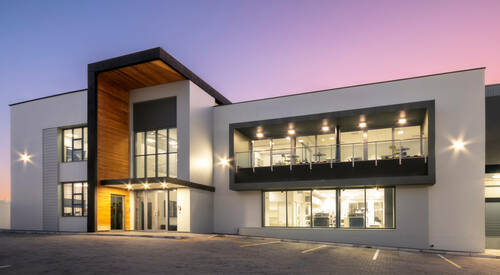commercial architects and Their Use of Green Roofing in Modern Developments
Wiki Article
Introducing the Comprehensive Providers Provided by Commercial Architects for Modern Developments
Commercial Architects serve a vital feature in modern advancement projects. They blend layout appearances with performance while adhering to regulative demands. Their knowledge expands past plain building and construction, integrating sustainable techniques and cutting-edge modern technologies. As they navigate complicated zoning legislations, Architects team up with different stakeholders to bring visions to life. This diverse strategy raises questions concerning the advancing role of Architects in forming modern areas and the impact of their service future developments.Understanding the Function of Commercial Architects in Modern Developments
In modern city landscapes, Commercial Architects play a critical role in shaping practical and visual areas that meet diverse organization demands. Their knowledge expands beyond mere layout; they navigate intricate zoning laws, constructing codes, and environmental laws. By working together with clients, they identify specific requirements, making certain that each project lines up with the client's vision while also considering practical aspects such as sustainability and cost-effectiveness. Commercial Architects are adept at integrating innovative modern technologies and products right into their layouts, boosting both the performance and power efficiency of buildings. They perform thorough site analyses to evaluate the possible challenges and possibilities provided by an area. In addition, effective communication with specialists and various other stakeholders is crucial, guaranteeing that the job progresses smoothly from perception to completion. Ultimately, Commercial Architects are important in creating areas that not only accomplish functional purposes however also add to the overall personality and vibrancy of urban atmospheres.Principle Design: Transforming Ideas Into Truth
Principle design works as an essential stage in Commercial architecture, where ingenious style services arise from innovative thinking. This procedure counts on joint ideation, bringing with each other varied point of views to refine and improve first concepts. As concepts materialize, they transform from abstract ideas into concrete building truths.Cutting-edge Design Solutions
Changing concepts into fact is the hallmark of innovative design remedies in Commercial architecture. These options mix creativity with performance, addressing the distinct requirements of modern-day advancements. By leveraging innovative modern technologies and sustainable methods, Architects craft areas that are not just aesthetically enticing yet additionally efficient and adaptable. Focus on individual experience drives the style procedure, making certain that settings foster productivity and partnership. Each project take advantage of a tailored approach, where concepts are thoroughly created to reflect the customer's vision while considering future trends. Innovative style remedies additionally focus on adaptability, permitting for adjustments in time as company demands develop. Eventually, these strategies enhance the overall value of Commercial rooms, making them critical in today's affordable landscape.
Collaborative Ideation Process
Collaboration serves as the backbone of the ideation process in Commercial style, cultivating creative thinking and development amongst diverse stakeholders. Architects, customers, engineers, and area participants take part in vibrant discussions, guaranteeing that all point of views are thought about. This inclusive technique permits for the expedition of various layout ideas, motivating distinct services that align with the task's vision. With workshops and conceptualizing sessions, concepts develop and refine, changing initial concepts right into concrete layouts. Modern technology also plays an essential role, with devices such as Building Information Modeling (BIM) facilitating real-time cooperation and changes. Ultimately, this collective ideation process not just improves the layout end result however likewise cultivates a sense of ownership and financial investment among all celebrations involved, causing effective Commercial developments.Zoning Evaluation: Navigating Regulations and Compliance
As programmers begin on new tasks, understanding zoning guidelines is necessary to making sure conformity and avoiding costly delays. Zoning evaluation plays a vital role in this process, as it entails evaluating neighborhood zoning legislations that dictate land usage, building height, density, and obstacles. Commercial Architects possess the proficiency to navigate these complicated policies, assisting customers recognize acceptable uses and any required variations.Sustainable Layout Practices: Building for the Future
Lasting style methods are increasingly vital in the domain name of Commercial design, specifically as environmental concerns continue to intensify. Architects focus on eco-friendly materials, energy-efficient systems, and design techniques that minimize waste and environmental influence. Including renewable power resources, such as photovoltaic panels and wind turbines, permits buildings to generate their own power and decrease reliance on fossil fuels.Furthermore, sustainable design stresses the value of interior ecological high quality. This includes making use of natural light, boosting ventilation, and selecting non-toxic materials to boost owner health and wellness and productivity. Green roofing systems and living walls are also popular attributes that add to biodiversity and metropolitan cooling.Additionally, Commercial Architects typically incorporate water conservation techniques, like rain harvesting and drought-resistant landscape design. With these innovative methods, they produce rooms that not only fulfill modern demands but likewise foster a lasting future, resolving the expanding demand for accountable advancement in the modern-day globe.Project Administration: Ensuring Timely and Efficient Implementation
Reliable job monitoring is crucial for making certain that Commercial architecture jobs are finished in a timely manner and within budget. This role encompasses a variety of duties, consisting of the sychronisation of various stakeholders, timelines, and sources. Commercial Architects utilize their competence to create detailed project plans that outline crucial milestones and deliverables, permitting organized development tracking.Regular communication amongst group participants and customers is critical, promoting transparency and promoting timely decision-making. Danger administration methods are likewise used to identify potential challenges early, allowing positive services to be developed. By making use of advanced project management devices, Architects can monitor project efficiency in real-time, making adjustments as needed to keep performance.Interior Layout: Developing Practical and Aesthetic Spaces
Interior decoration plays an essential function in enhancing both functionality and visual appeal within Commercial rooms. Efficient space planning can optimize process and improve user experience, while aesthetic style concepts add to a visually attractive environment - commercial architects. Together, these components produce rooms that are not just functional but likewise inspiringRoom Preparation Effectiveness
While maximizing the energy of readily available space, Commercial Architects focus on space planning efficiency to create both functional and visually pleasing environments. This technique entails mindful analysis of the spatial format to assure suitable usage of every square foot. Architects consider aspects such as operations, ease of access, and all-natural light to improve functionality. By tactically positioning furnishings, devices, and workstations, they promote movement and explanation communication among users, advertising efficiency. Furthermore, zoning various areas for specific features helps in taking care of sound and privacy, creating an unified environment. Via reliable area preparation, Commercial Architects can change restraints right into chances, ensuring that each room satisfies the varied needs of its passengers while adhering to regulatory needs and market criteria.Visual Design Principles
Visual design concepts play an important function in forming atmospheres that are not only functional however likewise aesthetically enticing. These principles guide Commercial Architects in developing spaces that reverberate with users while improving brand name identification. Secret aspects consist of balance, percentage, and harmony, which collaborate to produce a natural appearance. Color pattern and products are carefully picked to stimulate desired feelings and support the general theme. In addition, lighting plays a vital duty, affecting state of mind and exposure while highlighting building features. By integrating these principles, Architects ensure that areas are not only useful but additionally welcoming and inspiring. Inevitably, reliable aesthetic design promotes a favorable individual experience, urging engagement and contentment in Commercial environments.Cooperation With Stakeholders: Cultivating Effective Collaborations
Successful partnerships in Commercial design rest on effective partnership with stakeholders, making certain that every voice is listened to and valued. This collaborative technique includes engaging different celebrations, including clients, contractors, and neighborhood participants, throughout the layout and advancement process. By promoting open interaction, Commercial Architects can resolve problems, collect understandings, and line up the job's vision with stakeholder expectations.The integration of diverse perspectives boosts imagination and advancement, causing more functional and visually pleasing styles. Regular meetings, feedback sessions, and workshops facilitate this dialogue, allowing Architects to adapt their strategies in feedback to stakeholder input. Additionally, establishing depend on through openness and responsibility reinforces these partnerships, causing a smoother project execution.Ultimately, the success of contemporary developments depends upon the Architects' capacity to navigate and harmonize varying rate of interests, creating a joint environment that promotes common goals and common success.Regularly Asked Inquiries
Exactly How Do Commercial Architects Deal With Budget Plan Constraints Throughout a Project?

What Sorts of Software Do Commercial Architects Commonly Use?
Commercial Architects typically use software such as AutoCAD for composing, Revit for Building Info Modeling, SketchUp for site here 3D modeling, and project administration devices like Microsoft Task to improve partnership and improve operations throughout the layout process.Can Commercial Architects Help With Acquiring Funding for Projects?
Commercial Architects can aid in acquiring funding for tasks by preparing comprehensive proposals, helping to express style visions, and giving monetary estimates that can boost the likelihood of protecting needed funding from financiers or banks.Just How Do Architects Ensure Safety Throughout the Construction Process?
Architects ensure security throughout building and construction by applying extensive design standards, collaborating with engineers, carrying out routine site examinations, adhering to regional guidelines, and cultivating interaction among all stakeholders to mitigate risks and advertise a secure working atmosphere.What Continuous Assistance Do Architects Give After Job Conclusion?
After task conclusion, Architects use continuous assistance through maintenance appointments, efficiency assessments, and style adjustments. They guarantee structures meet developing needs, address prospective concerns, and keep compliance with guidelines, cultivating a lasting partnership with clients.Report this wiki page